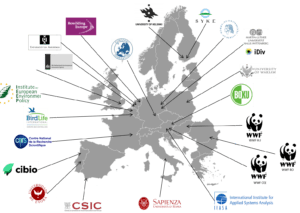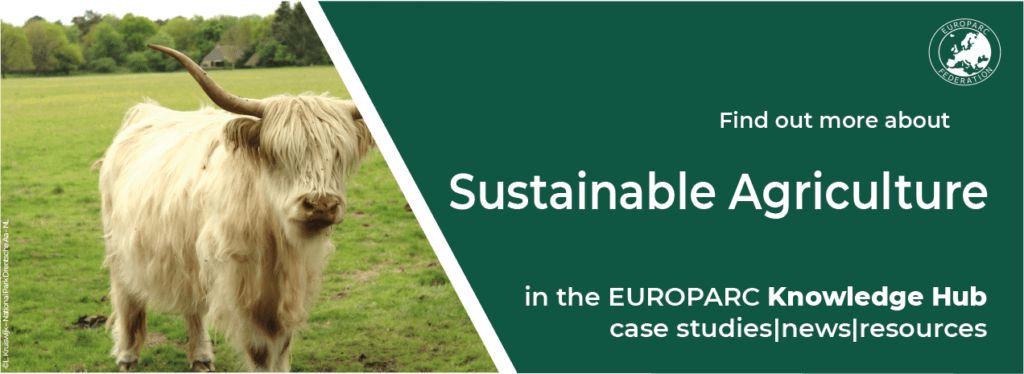EUROPARC Webinar, 1.12: Spotlight on Youth
We invite you to the next EUROPARC webinar “Spotlight on Youth – Creating opportunities for young people in and around Protected Areas”.
- 1.12.
- 15:00 – 16:00 CET
- Free, but registration is mandatory
The webinar
Young people are the future of Protected Areas in Europe.
As such, EUROPARC believes our Parks and Protected Areas should make sure that young people have a role in shaping and building this future, today. After all, youngsters can make a great contribution to their local community when encouraged to participate in nature orientated events – and Protected Areas are well-placed to give them this opportunity.
The EUROPARC Youth Manifesto, launched in 2018, paved a way with clear visions of a future built together with youth, Protected Areas and local municipalities. Since then, there have been many initiatives to implement these visions on local levels.
In this webinar we want to showcase three examples where Protected Areas have implemented various projects to increase opportunities for young people to take up active roles in their Protected Areas and local communities. Get inspired, and see how your Protected Area can support and empower youth, to create the green future of tomorrow!
The Programme
Welcome and Introduction
Jessica Micklem-Kolenić, EUROPARC Federation
The Cairngorms Youth Action Team
Iona Kellas, Cairngorms National Park, Scotland
The International Youth+ Volunteer Summer Experience
Johanna Ugander, Kullaberg Nature Reserve, Sweden
The Up Skill Down Dale Programme
Caroline Hall, Yorkshire Dales National Park, England
Q&A
Discussion with Participants
The Speakers
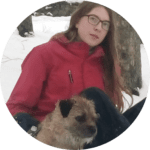
Iona Kellas
Cairngorms Youth Action Team member, Cairngorms National Park, Scotland
Iona has been active in the Cairngorms National Park as a Junior Ranger since she was 12 years old. Her passion for nature and the Protected Area led her to continue her engagement as a member of the Cairngorms Youth Action Team for the last 3 years.
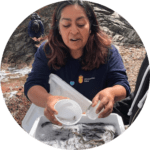
Johanna Ugander
Nature Guide at Kullaberg Nature Reserve, Sweden
Johanna loved the experience of working with a mixture of different ages, cultures and countries which took place at this year’s pilot Youth+ volunteering in Sweden. She is looking forward to having more opportunities to work with international Youth+ in the future. As a nature guide, Johanna works on getting people as excited about nature as she is.
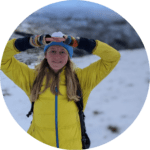
Caroline Hall
Youth Volunteer Officer at the Yorkshire Dales National Park Authority, England
Caroline is passionate about working with young people, especially groups who face barriers to accessing nature. She is also an experienced mental health practitioner and forest school practitioner and feels very lucky to be able to work outside with brilliant groups of young people!
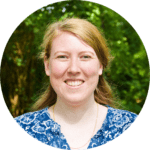
Jessica Micklem-Kolenić
Youth Officer at the EUROPARC Federation
Jessica is passionate about meaningful youth engagement and has been volunteering as a youth activist in European and International biodiversity policy spaces. Her main task at EUROPARC is to support the administration and implementation of various youth activities across all of EUROPARC’s initiatives.

NaturaConnect website is online!
Mas Larrieu National Reserve, France, Copyright EUROPARC Federation, Credit Lee Kershaw
Europe needs healthy ecosystems that benefit biodiversity and people and are resilient to climate change. The Horizon Europe NaturaConnect Project will support European Union governments and other public and private institutions in designing a coherent, resilient and well-connect Trans-European Nature Network.
Protecting and connecting nature across Europe
EUROPARC Federation is bringing its wealth of experience of Protected Areas by joining a new consortium under the Horizon applied research project NaturaConnect. The activities started in July 2022 and will run until June 2026.
What is the background for the NaturaConnect project?
In October 2020, European Union Member States committed to legally protect a minimum of 30% of the European Union’s land and sea area and to strictly protect at least a third of these protected areas. This is expected to contribute to the European Green Deal’s goal of preserving and restoring Europe’s natural capital as well as taking a leading role in the Post-2020 Convention on Biological Diversity (CBD) Framework.
One of the cornerstones of this strategy is to develop a coherent Trans-European Nature Network (TEN-N) to function as a connected system through ecological corridors with natural and semi-natural areas. If appropriately managed, this can deliver a wide range of benefits for biodiversity and people.
To help the European Union and its Member States to realize their ambitious strategy for protected areas, the European Union Horizon Europe Research and Innovation Programme funded the NaturaConnect project. NaturaConnect brings together 22 partner institutions*. The coordination is jointly managed by the International Institute for Applied System Analysis (IIASA), the German Centre for Integrative Biodiversity Research (iDiv) and Martin Luther University Halle-Wittenberg (MLU).
What does the project team do?
Working closely with protected area managers, conservation organizations, and other stakeholders, the project team will conduct research, engagement, and dissemination activities across Europe to identify the best areas to protect and connect to preserve biodiversity and adapt to climate change. The team will also work with national and sub-national nature conservation agencies and other stakeholders within six case studies to test and refine their approaches and inform local ongoing conservation efforts. One such example is the Carpathian-Danube region, where NaturaConnect will evaluate the connectivity design and implementation challenges in a trans-boundary area encompassing ten different European Union countries.
What are the project aims?
The project aims to:
- Support planning authorities, by collecting and making accessible the best available data and tools to assess biodiversity and the benefits to people
- Provide input to planning authorities into the design of an effective Trans-European Nature Network by anticipating future developments in climate and land use conditions that may limit or enable the development of such a network
- Identify alternative configurations of protected areas and corridors based on preferences related to policy targets
- Identify opportunities and challenges to the implementation of the network, mechanisms, and instruments of implementation, particularly financial instruments and ways to mitigate barriers through extensive dialogue with practitioners, capacity building, and decision support
- Showcase applications of the protected area network design through case studies
Who are the 22 partners?
Our partnership includes:
International Institute for Applied System Analysis (project lead; Austria); German Centre for Integrative Biodiversity Research (iDiv) Halle-Jena-Leipzig (project co-lead; Germany); Associacao Biopolis (Portugal); BirdLife Europe (Netherlands); Birdlife International (United Kingdom); Centre National De La Recherche Scientifique (France); Doñana Research Station – Agencia Estatal Consejo Superior De Ivestigaciones Cientificas (Spain); EUROPARC Federation (Germany); Finnish Environment Institute (Finland); Humboldt-University of Berlin (Germany); Institute for European Environmental Policy (Belgium); Netherlands Environmental Assessment Agency (Netherlands); Rewilding Europe (Netherlands); University of Evora (Portugal); University of Helsinki (Finland); University of Natural Resources and Life Sciences, Vienna (Austria); University of Rome La Sapienza (Italy); University of Warsaw (Poland); Vrie University of Amsterdam (Netherlands); WWF Central and Eastern Europe (Austria); WWF Romania and WWF Hungary.
Where can I get more information?
The project has a new website, where you can get detailed information about the work of the partners leading different technical areas and case studies as well as publications and research opportunities!
You can also follow the project on LinkedIn and Twitter

The Kullaberg Nature Reserve Youth+ Experience
In the summer of 2022, Kullaberg Nature Reserve invited two groups of Youth+ to stay, work, learn and share their experiences over the course of two three-week periods. These 9 young people came from Austria, Estonia, Italy, Latvia, the Netherlands, Slovenia, Spain and Switzerland – a very international EUROPARC experience!
Article issued by Moritz Mairl
The Kullaberg Nature Reserve Youth+ Experience
Kullaberg Nature Reserve is located on a peninsula in southern Sweden. and is one of the most visited protected areas in Sweden thanks to its unique landscape, rich biodiversity, and cultural history. Over the course of 3 weeks, the two groups of Youth+ were involved in many different aspects of Protected Area management, incorporating all the four pillars of the Youth+ programme into their work: Nature Conservation, Communication, Leadership and Advocacy.
Nature conservation and recreational space are very close to each other in the area. Visitor management therefore plays a very important role in the Protected Area management. Both Youth+ groups spent many days in the sun, rain and wind, collecting visitor surveys which are used to gather important information about possible conflict points between nature conservation and tourist recreation. These data will be incorporated into a long-term visitor management program. Visitor management also included practical work. For example, we extended a hiking trail with wooden planks to keep visitors on the trail and to protect the vegetation.
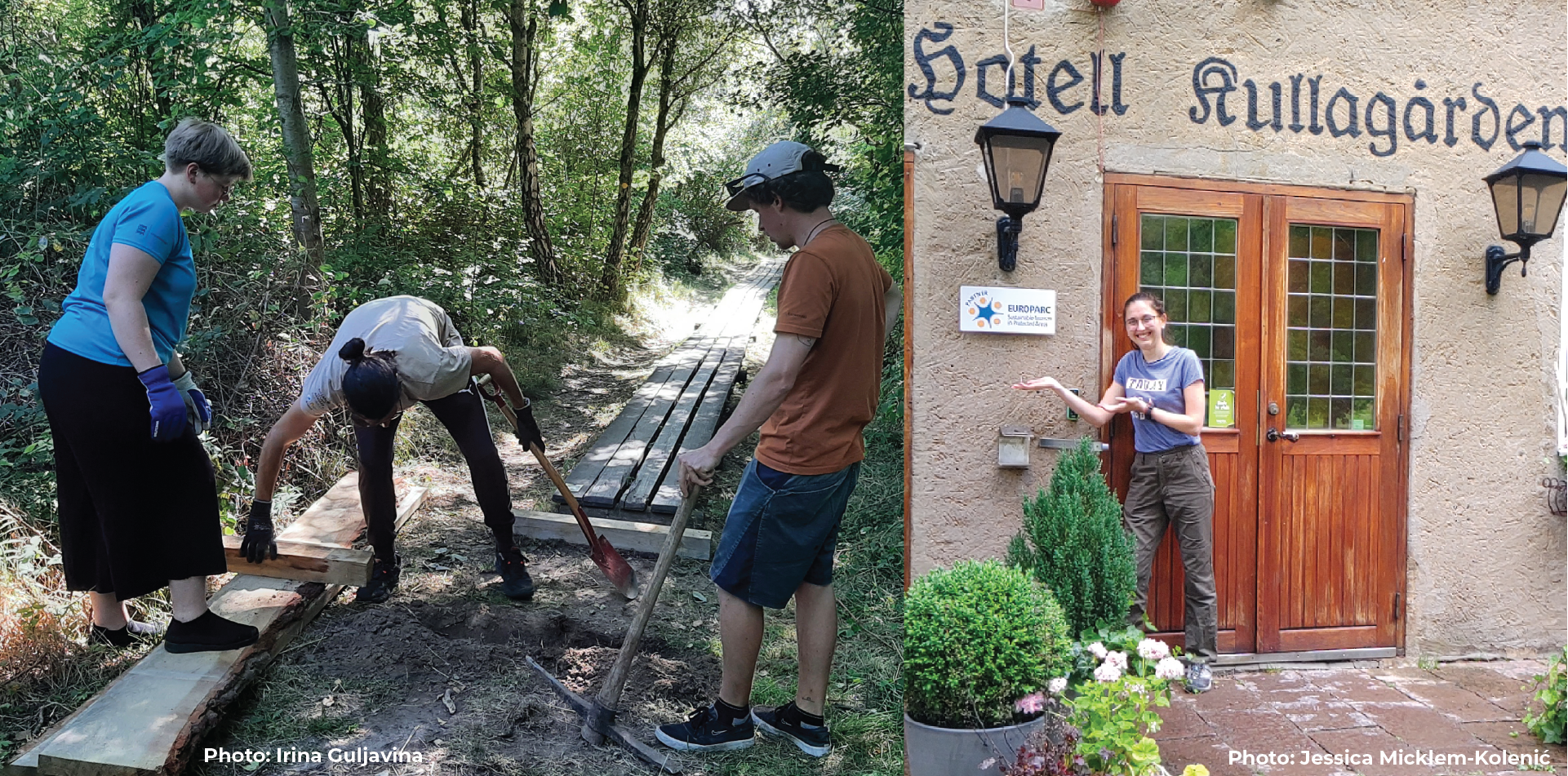
The Youth+ group assisting with trail building and with surveys for the European Charter for Sustainable Tourism
The history of the Nature Reserve is marked by tourism and cultural landscapes. Our meetings with local actors were very informative and brought the history of the region to life. And what better way to talk about the beginnings of the bathing culture in Mölle than during a classic fika (a traditional Swedish coffee and cake break). In the future, the local community plan to be even more involved with the European Charter of Sustainable Tourism, a great way for local businesses and the park to facilitate long-term sustainable development in and around the Protected Area.
While meeting with a local farmer, on the other hand, there was no time for a fika. Sheep had to be unloaded, and the cultural landscape that has been maintained for centuries should continue to be preserved. Even if the work is now only financially viable through subsidies, the cultural heritage is preserved and by working with old native breeds of sheep and cows, the farmer contributes to the promotion of biodiversity. A work that should receive far more recognition and access to financial support.
Nature is also changing in Sweden. Invasive species threaten the native flora and fauna. To curb the problem, the Youth+ assisted with both tangible actions (uprooting invasive plants) and education of the local community and tourists. At the same time, new habitat have been created for rare native species. Due to a lack of deadwood in the forest, bats find it difficult to find enough nesting holes. To counteract this problem, the International Youth+, the local Youth+ and the Kullaberg Junior Rangers have been building some bat houses and installed them in the forest. We hope for numerous inhabitants!
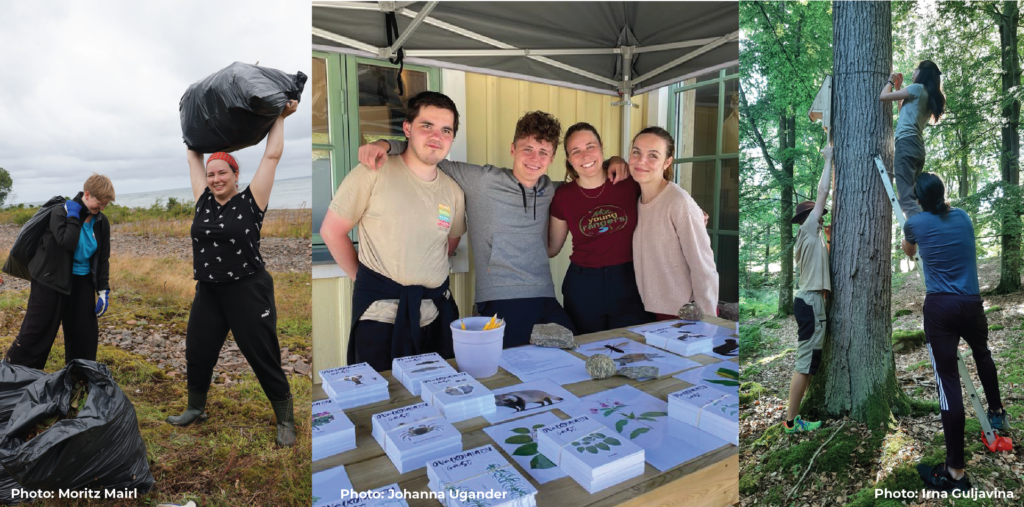
The Youth+ eradicated invasive species, helped raise awareness about their danger to local species, and put up bat houses for conservation.
The Kattegat Strait between Denmark and Sweden is one of the busiest shipping routes in the world. This became very clear when looking out from the lighthouse, the landmark of the nature reserve. Nevertheless, many sea creatures feel extremely comfortable around the peninsula. Lessons about the marine and shoreline life in the area allowed the Youth+ to better understand the biodiversity of the region and experience it first-hand, whether in the Naturum (the visitor centre), while snorkeling or during a Porpoise Safari. Even garbage collecting became an exciting job when you can search for garbage in a kayak or boat along the impressive cliffs!
The Kullaberg Nature Reserve offers enormous diversity in a relatively small area. The participants, each of whom has already gained experience in Protected Areas in their home countries, appreciated this. But what about the young people in the region around the nature reserve? This question was explored in a design thinking workshop.
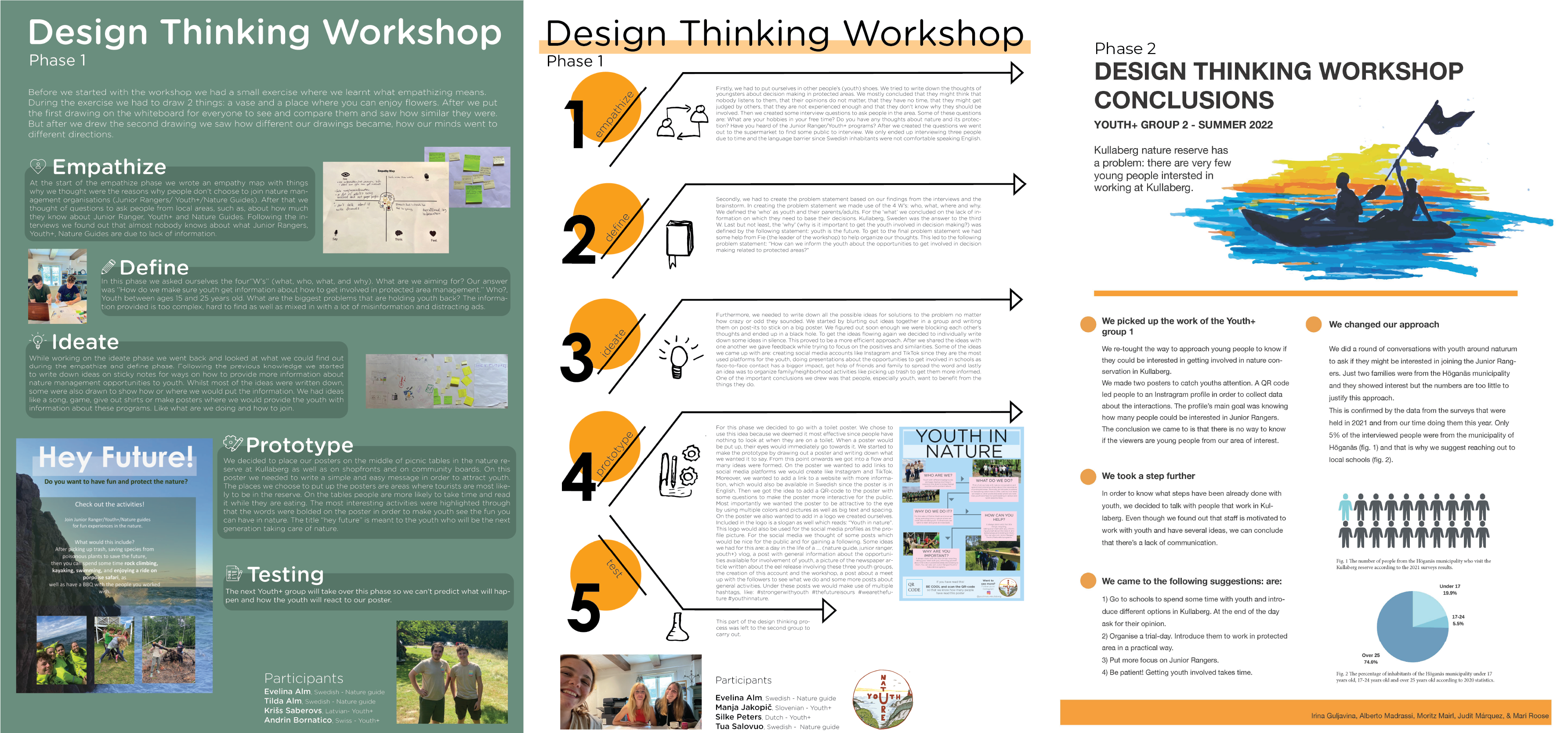
The three posters explaining the Design Thinking Process of Groups 1A, Group 1B (both doing Phase 1) and Group 2 (doing Phase 2)
You can download them here:
Group 1A: Process & Poster
Group 1B: Process & Poster
Group 2: Process & Poster
The Youth+ groups worked together with the local Naturvärdar (a local seasonal youth workers in Kullaberg Nature Reserve), following the design thinking process to evaluate how the Protected area could engage more young people. The first group of Youth+ started the process by interviewing local teenagers and young adults. As a group, problems were recorded, new solution-focused strategies were developed and tested. Posters were used to make young people in the nature preserve aware of what opportunities exist for participation. Interactions with the posters were then tracked on social media using QR codes. The results were evaluated together. Design thinking is a non-linear process that involves setbacks and many questions. For example, the poor interaction with the posters led to some frustration, but also to the development of new solutions and strategies.
The second Youth+ group then continued the design-thinking process to look at how young people can be better reached and what it takes to keep them involved in the park’s work. As an outcome of the workshop, posters and scripts were developed, which present strengths, weaknesses and possible courses of action for Kullaberg Nature Reserve. This should help the management of the reserve to be more active in the field of youth work in the future. Since Kullaberg Nature Reserve is considered the flagship for EUROPARC youth programs in Sweden, in the best case this can have an impact on the whole country!
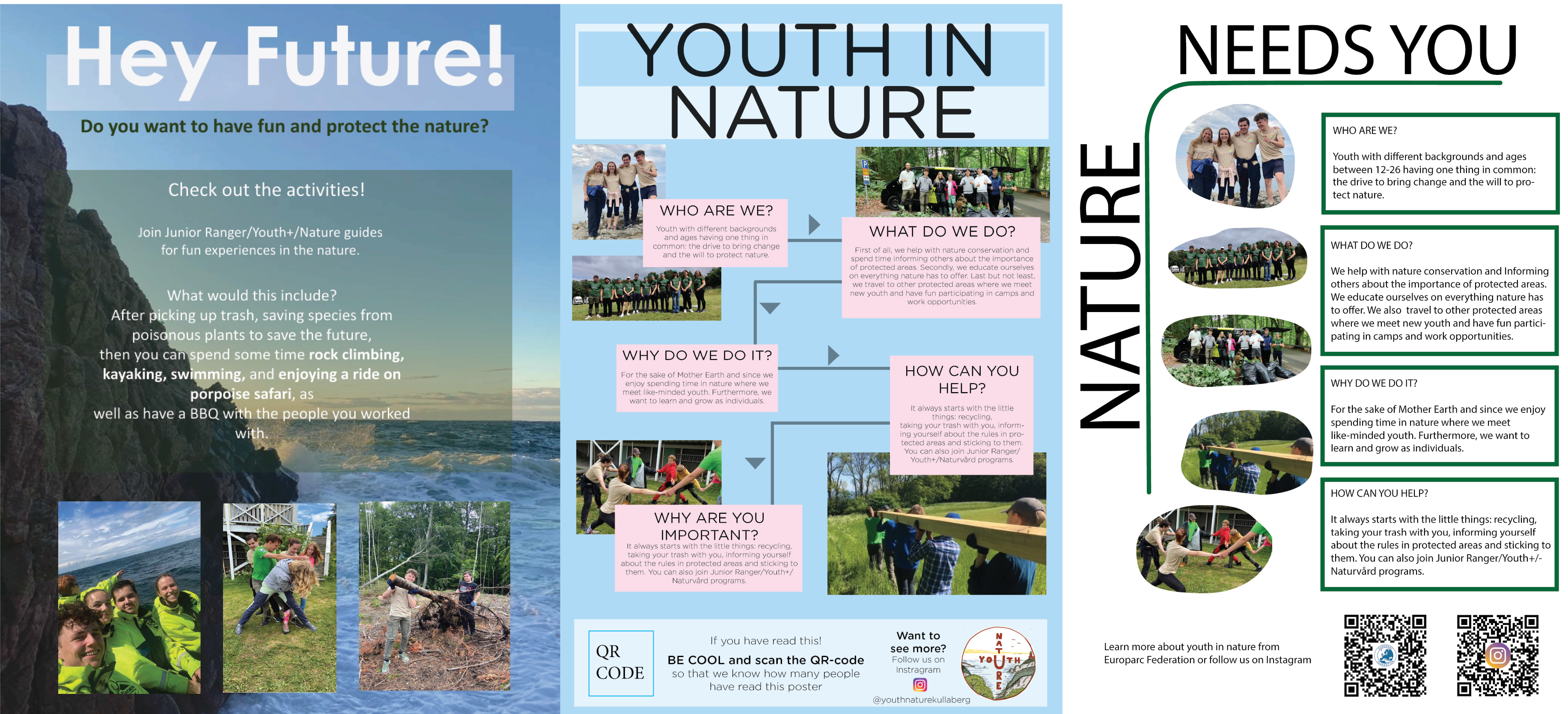
Advertising youth engagement in Kullaberg Nature Reserve
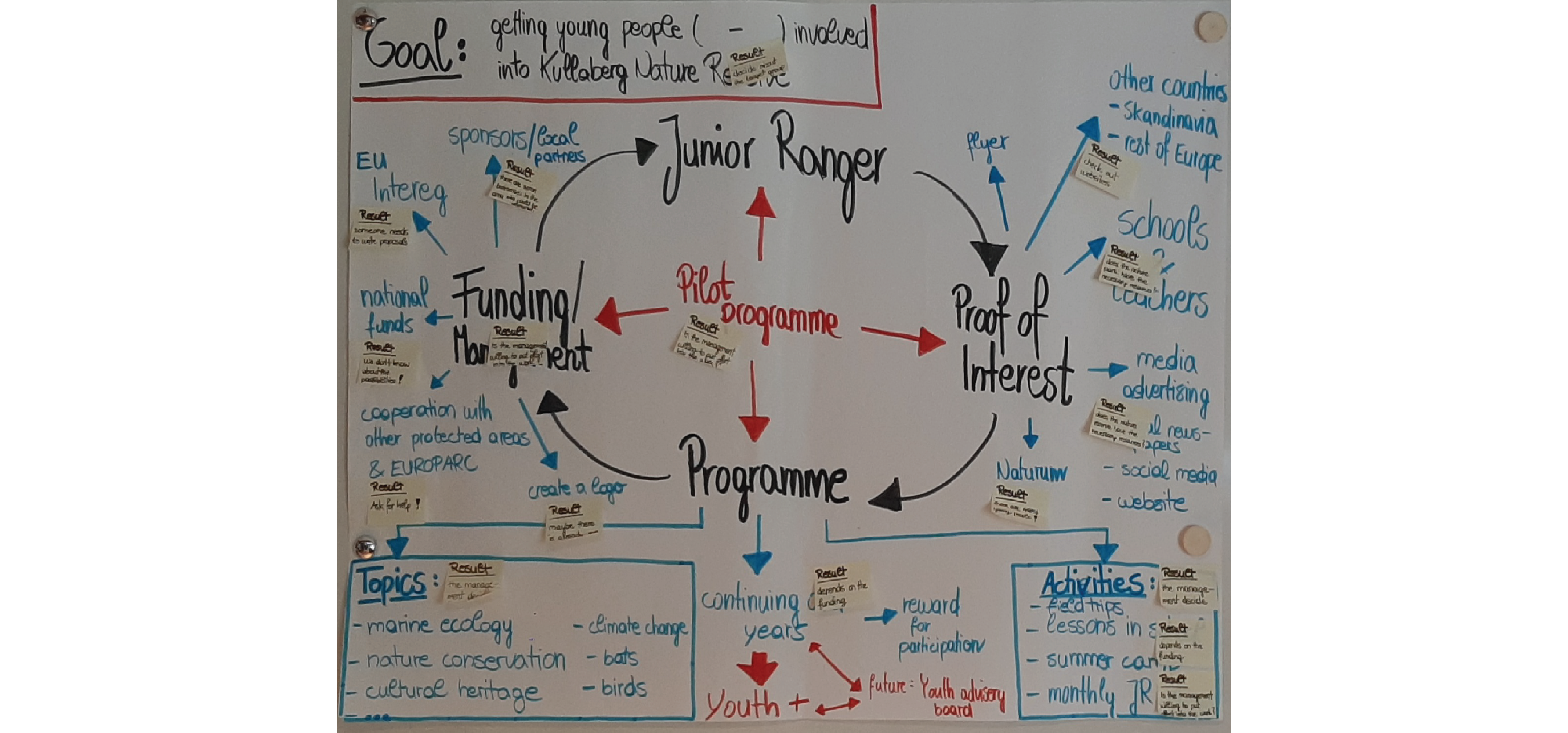
A diagram of the youth involvement process at Kullaberg Nature Reserve
At the end of the three weeks, each of the Youth+ participants prepared a presentation of their home Protected Areain which they had already gained experience. The local staff, Youth+ and Junior Rangers were excited to hear how other Protected Areas were running their Junior Ranger and Youth+ programmes. The audience was eager to travel and experience this first-hand, and plans were made to travel together.
In addition to the insights into the work of the Protected Area, there was also time to get to know Sweden better. Some participants visited Gothenburg, Lund, Malmö, Helsingborg and thanks to the proximity to Denmark also Helsingør. Not only cities, but also the other nature reserves of southern Sweden were explored. The notorious bathing culture became a social event during the early morning swim. To recover from the cold of the sea, the sauna in the accommodation was heated up several times in the evening. The participants also used their free time to better explore the surrounding area. Lonely bays, breathtaking sunsets and jumping tunas were among the absolute highlights here. Barbecue evenings, cooking together (seaweed pasta, köttbullar and much more), a crayfish party, movie nights and karaoke swore the participants together to a team and made the time in Sweden fly by and new friendships developed. Nobody will forget this great time so quickly!
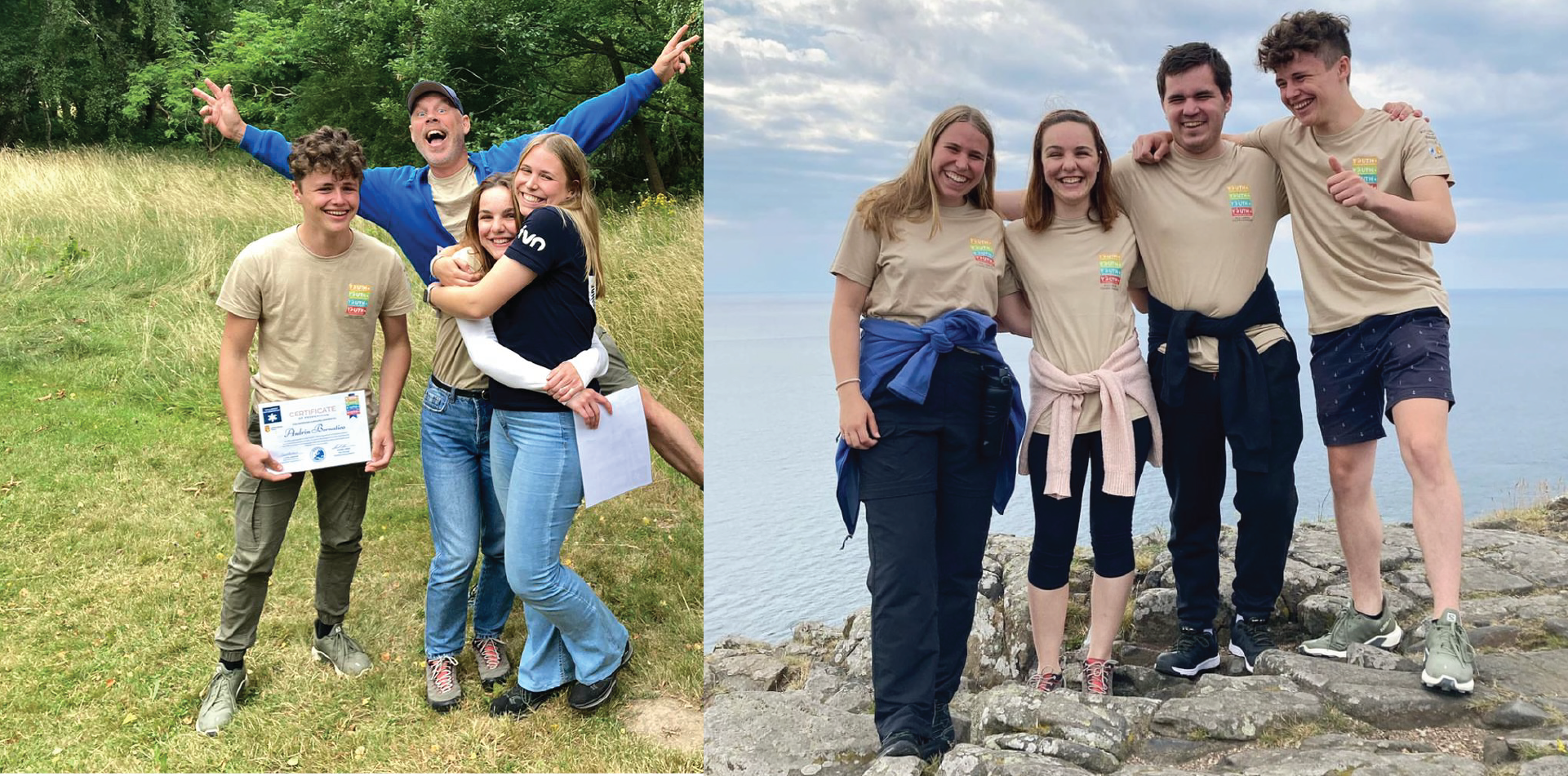
The first group: Silke Peters (NL), Manja Jakopič (SI), Krišs Atvars Saberovs (LV), and Andrin Bornatico (CH)
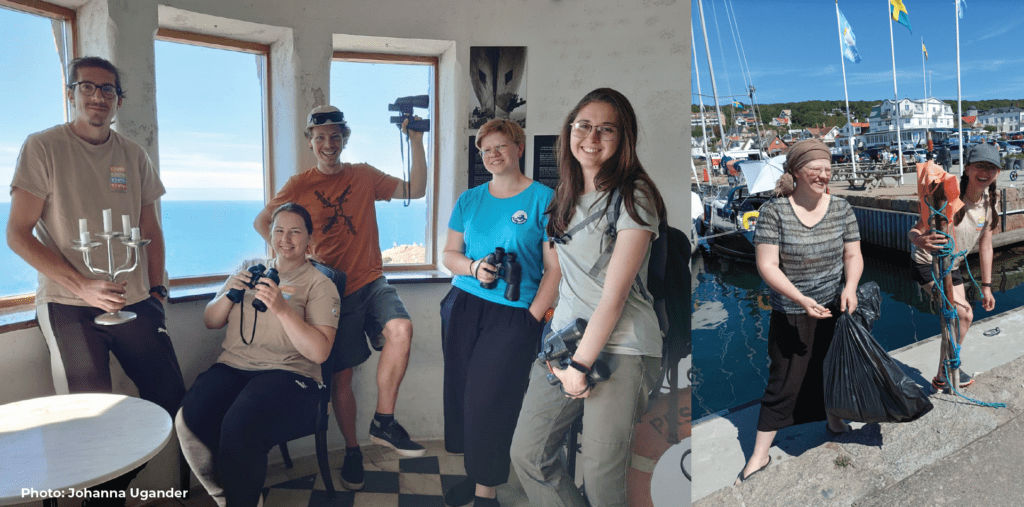
The second group: Alberto Madrassi (IT), Irina Guljavina (EE), Moritz Mairl (IT/AT), Mari Roose (EE), and Judit Márquez Pérez (ES),
This work was supported by:

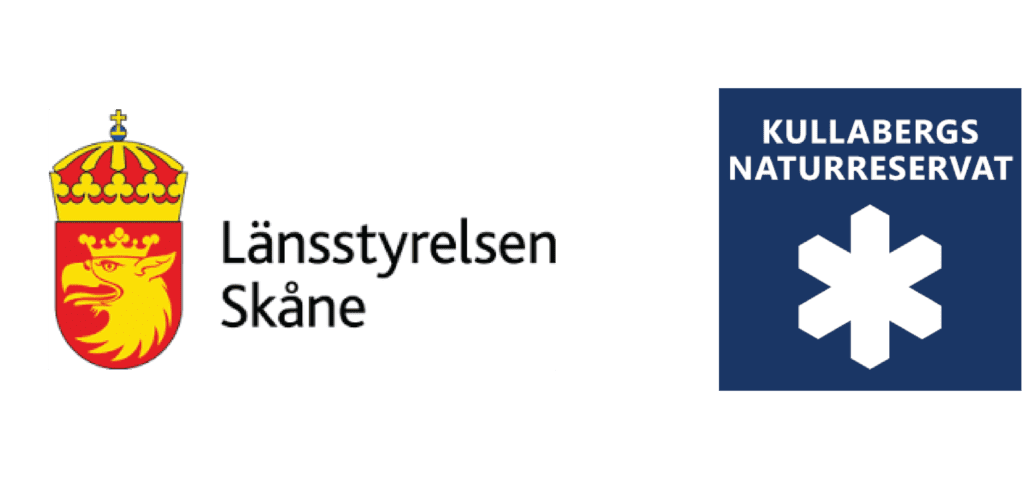
Cooperating for Biodiversity: the case of Schiermonnikoog in the Netherlands
In the Netherlands, farmers are protesting the government’s plans to cut nitrogen emissions. This article details the innovative plan created by farmers at Schiermonnikoog that will cut emissions, whilst ensuring the farmers’ livelihoods.
The Nitrogen problem
Agriculture is essential to support human life, but it can also be destructive to nature when practised too intensely. Cattle produced manure, as well as fertilizers, emit high levels of greenhouse gases, amongst which nitrogen. This calls for legislation, policies, and most of all, collaboration, amongst the parties involved to work together toward a more sustainable way of farming. EUROPARC believes that only in working together with farmers, we can reach long-term, sustainable solutions that are Good for People and Good for Nature.
The Netherlands, like other EU countries, is required to protect nature. This pertains especially to the protection of the 162 Natura 2000 areas in the country. For years, the expulsion of nitrogen in The Netherlands has been too high, resulting in damaged and vulnerable nature.
40% of the nitrogen affecting Natura 2000 areas comes from the agricultural sector. This is because of the high amount of cattle in relation to the amount of square meters. The steps undertaken to actively battle the problem have only had limited effects so far. In order to reach the climate goals by 2030, the government plans aim to reduce greenhouse gas nitrogen by 70 percent, mainly in farming areas close to nature reserves. Now, it is clear that in order to drastically reduce the nitrogen output, the amount of cattle in the Netherlands will need to be reduced as well. This poses the question:
Is there a way for farmers and the government to work together towards what is, in the end, a shared goal?
The Schiermonnikoog Island case study detailed here is doing just that.
Cooperating for Biodiversity: the case of Schiermonnikoog in the Netherlands
In the Dutch Waddensea, on the Island of Schiermonnikoog, there are seven dairy farmers. Almost the entire island is designated as a National Park.
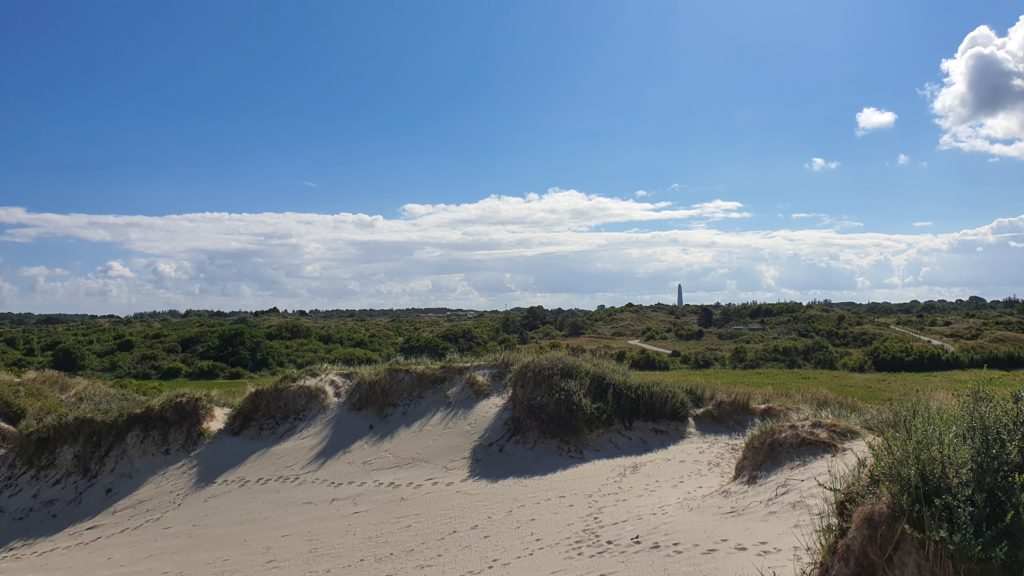
Dune Area at Schiermonnikoog Island © Esther Bossink, EUROPARC
According to the Natura 2000 Schiermonnikoog Management Plan, the nitrogen emissions from agriculture on the vulnerable dunes of Schiermonnikoog are too high. The Dutch government has taken measures by issuing a nitrogen legislation that will mean drastic changes for the agricultural sector. Initially, the province planned to buy farmers out.
As former EUROPARC Intern Lisanne Kruiswijk mentions in her report “From production and protection paradigms to a landscape approach”, the farmers opposed to this idea. Instead, they came up with a collaborative plan. A solution through which the seven dairy farmers of the island would implement nature-promoting measures, including a voluntary decline in the number of cows by no less than 35%.
The pillars of the project
The main goal of the project is the realization of biodiverse agriculture on the island. Together with Natuurmonumenten and other parties, the dairy farmers have drawn up a joint target for 2030. The three pillars on which the project stands are:
1. The realization of biodiverse agriculture on the island: Measures will be implemented to make agriculture on the island more biodiverse, such as strip cultivation, healthier soil life and a substantial reduction in livestock.
2. Producing and selling own dairy products from the Island: The loss of income due to the downsizing of the livestock of cows will be compensated by the creation of a cheese factory on the island, and selling island cheese products.
3. Residual flows: The farmers take care of the residual flows that agricultural production entails. For example, farmers are investigating how best to deal with matters such as:
- Grass clippings from the salt marsh
- Verge clippings
- Cleaning the locks
- Whey from future cheese production
- Solid manure
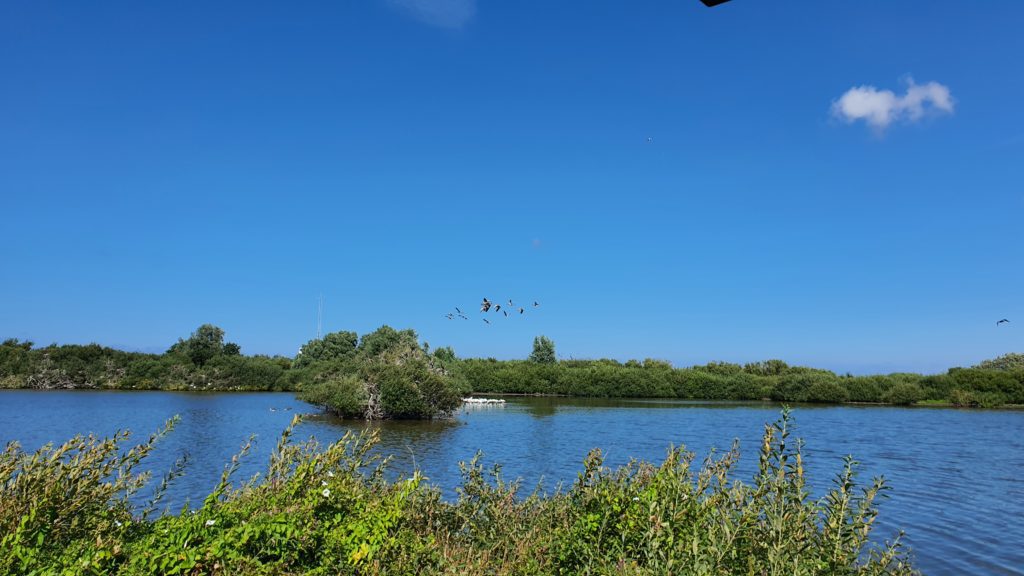
Westerplas at Schiermonnikoog, an important resting place for birds © Esther Bossink, EUROPARC.
The project is financially supported partially by the state, and a big push comes also from the European CAP pilot, in the framework of the agricultural European Innovation Partnership (EIP-AGRI).
Takeaways
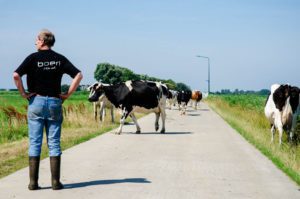
Farmer with cows in Schiermonnikoog
On Schiermonnikoog the farmers are working closely with the government and the business community, such as the Louis Bolk Institute, Ministry of Agriculture, Nature and Food Safety, Provincie Fryslân, Gemeente Schiermonnikoog, D&U Advies, Rabobank, Natuurmonumenten and FrieslandCampina.
Cooperation and collaboration are key to protecting both farmers’ and nature’s interests, and in this case, the location and setup of the island, where stakeholders are highly dependent on one another, played a significant role.
The way forward
This is a great example of a collaborative approach that could be implemented elsewhere. Whilst, there are still roadblocks to tackle, the work on Schiermonnikoog can be seen as “flagship” project on collaboration between farmers, nature managers, private companies and governmental institutions. It reminds us once again that
Alone you go faster, together you go further
Read the full case study here.
